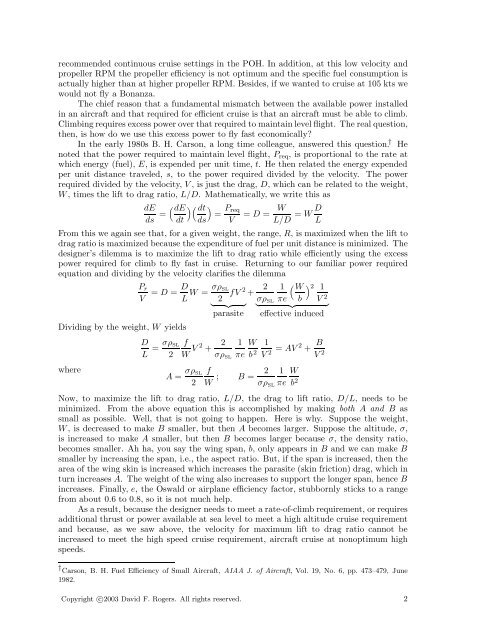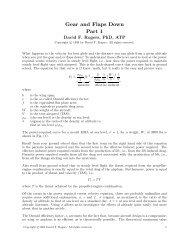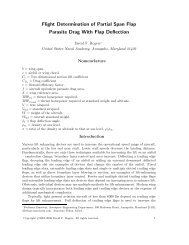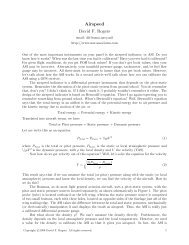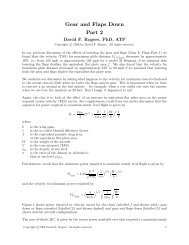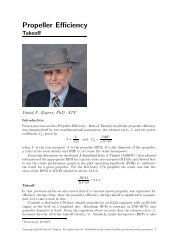Efficiently Wasting Fuel - NAR Associates
Efficiently Wasting Fuel - NAR Associates
Efficiently Wasting Fuel - NAR Associates
Create successful ePaper yourself
Turn your PDF publications into a flip-book with our unique Google optimized e-Paper software.
ecommended continuous cruise settings in the POH. In addition, at this low velocity and<br />
propeller RPM the propeller efficiency is not optimum and the specific fuel consumption is<br />
actually higher than at higher propeller RPM. Besides, if we wanted to cruise at 105 kts we<br />
would not fly a Bonanza.<br />
The chief reason that a fundamental mismatch between the available power installed<br />
in an aircraft and that required for efficient cruise is that an aircraft must be able to climb.<br />
Climbing requires excess power over that required to maintain level flight. The real question,<br />
then, is how do we use this excess power to fly fast economically<br />
In the early 1980s B. H. Carson, a long time colleague, answered this question. † He<br />
noted that the power required to maintain level flight, P req , is proportional to the rate at<br />
which energy (fuel), E, is expended per unit time, t. He then related the energy expended<br />
per unit distance traveled, s, to the power required divided by the velocity. The power<br />
required divided by the velocity, V , is just the drag, D, which can be related to the weight,<br />
W , times the lift to drag ratio, L/D. Mathematically, we write this as<br />
dE ( dE )( dt )<br />
ds = dt ds<br />
= P req<br />
V = D = W<br />
L/D = W D L<br />
From this we again see that, for a given weight, the range, R, is maximized when the lift to<br />
drag ratio is maximized because the expenditure of fuel per unit distance is minimized. The<br />
designer’s dilemma is to maximize the lift to drag ratio while efficiently using the excess<br />
power required for climb to fly fast in cruise. Returning to our familiar power required<br />
equation and dividing by the velocity clarifies the dilemma<br />
P r<br />
V = D = D L W = σρ SL<br />
2 fV 2 + 2 1 ( W ) 2 1<br />
σρ<br />
} {{ } SL πe b V<br />
} {{ 2<br />
}<br />
parasite effective induced<br />
Dividing by the weight, W yields<br />
where<br />
D<br />
L = σρ SL f<br />
2 W V 2 + 2 1<br />
σρ SL πe<br />
A = σρ SL<br />
2<br />
W<br />
b 2 1<br />
V 2 = AV 2 + B V 2<br />
f<br />
W ; B = 2 1 W<br />
σρ SL πe b 2<br />
Now, to maximize the lift to drag ratio, L/D, the drag to lift ratio, D/L, needs to be<br />
minimized. From the above equation this is accomplished by making both A and B as<br />
small as possible. Well, that is not going to happen. Here is why. Suppose the weight,<br />
W , is decreased to make B smaller, but then A becomes larger. Suppose the altitude, σ,<br />
is increased to make A smaller, but then B becomes larger because σ, the density ratio,<br />
becomes smaller. Ah ha, you say the wing span, b, only appears in B and we can make B<br />
smaller by increasing the span, i.e., the aspect ratio. But, if the span is increased, then the<br />
area of the wing skin is increased which increases the parasite (skin friction) drag, which in<br />
turn increases A. The weight of the wing also increases to support the longer span, hence B<br />
increases. Finally, e, the Oswald or airplane efficiency factor, stubbornly sticks to a range<br />
from about 0.6 to 0.8, so it is not much help.<br />
As a result, because the designer needs to meet a rate-of-climb requirement, or requires<br />
additional thrust or power available at sea level to meet a high altitude cruise requirement<br />
and because, as we saw above, the velocity for maximum lift to drag ratio cannot be<br />
increased to meet the high speed cruise requirement, aircraft cruise at nonoptimum high<br />
speeds.<br />
† Carson, B. H. <strong>Fuel</strong> Efficiency of Small Aircraft, AIAA J. of Aircraft, Vol. 19, No. 6, pp. 473–479, June<br />
1982.<br />
Copyright c○2003 David F. Rogers. All rights reserved. 2


